Washing is the process of removing loosely bonded surface contaminants, such as dust, dirt, flies and road salt, from the exterior surfaces of your car. There are no golden rules about how often washing needs to be done, but a weekly routine will usually enable you to stay on top of the dirt and grime and keep your car looking good most of the time.
The most important thing to remember about washing is that more often than not you are working on dirty surfaces. Your choice of products and technique is therefore very important, as you want to be able to gently lift away dirt and grime without damaging the underlying surfaces or stripping away existing wax or sealant protection. For this reason, we recommend the use of a lambswool wash mitt in place of a traditional sponge, and the use of a gentle shampoo in conjunction with the two bucket method.
If you examine traditional sponges and think about the washing process, it should become obvious to you that they are poorly suited to the task. This is because they provide no means of lifting particles of dirt safely away from the surfaces being washed. Instead, dirt particles are trapped against the face of the sponge and moved around over the underlying surfaces, creating fine scratches that are commonly referred to as swirl marks. The potential for inflicting such damage is greater during the winter months, when coarser particles of grit and road salt tend to accumulate on the exterior surfaces of your car in between washes.
In contrast to sponges, lambswool wash mitts feature a deep pile that enables particles of dirt to be drawn safely away from the surfaces being washed. Moreover, because the pile is fairly loose, particles of dirt can easily be rinsed out. These benefits can be reinforced by using the two bucket method, in which the first bucket is filled with suds and the second with rinse water. The idea behind this method is to load the mitt with suds, wash one panel of the car and then rinse the mitt thoroughly in the second bucket to release any trapped particles of dirt, before reloading the mitt with suds and moving on to the next panel.
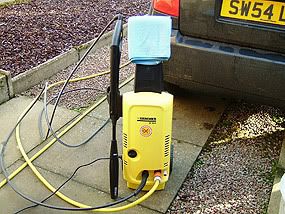
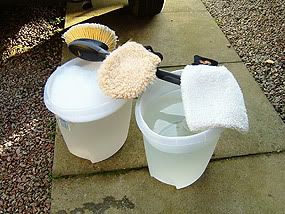
The only downside of using lambswool wash mitts is that they are fairly delicate, and can easily be damaged by harsh use and snagging. For this reason, we recommend switching to a microfibre wash mitt when washing wheels and the insides of wheel arches. These areas tend to suffer from significant accumulations of gritty particles, and also tend to have a greater number of potential snags. However, because microfibre mitts have a shorter pile than lambswool mitts, extra care should be taken to rinse them regularly, in order to minimise the risk of marking delicate alloy rims. This risk can be further minimised by pre-washing wheels and the insides of wheel arches with a soft tipped scrubbing brush.
In order to generate a bucket of suds, you will need to add 1-2 oz of shampoo to an empty bucket and then fill it with lukewarm water. Your choice of shampoo is important, as it needs to be tough enough to dissolve dirt and grime, but at the same time not so aggressive as to strip or degrade existing wax or sealant protection. Many shampoos on sale in high street stores are actually quite aggressive, and thus best avoided - if you wash and protect your car regularly a gentle shampoo will suffice, as any dirt and grime will be loosely bonded and easy to remove. Many good quality shampoos also contain natural or synthetic oils, which encapsulate particles of dirt, further reducing the risk of inflicting swirl marks.
When it actually comes to the washing process, the first thing you should do is rinse as much dirt and grime off your car as possible using a hose or a pressure washer. If you opt for the latter use an RCD safety device and don't be too aggressive with the power setting - high pressure jets can strip paint from sharp edges (around wheel arches for example) and knock sticky balancing weights off alloy rims. It is worthwhile taking the time to thoroughly rinse the wheels and the insides of the wheel arches at this stage, as it makes later work with the microfibre wash mitt easier and less mucky.
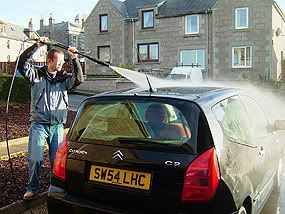
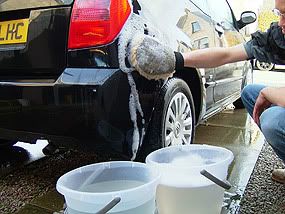
After initial rinsing, the next thing you should do is wash all of the exterior surfaces bar the wheels and the insides of the wheel arches using a lambswool wash mitt in conjunction with a gentle shampoo and the two bucket method. Start with the roof, and then work down, washing the windows, the bonnet, the boot, the upper halves of the sides, the lower halves of the sides and finally the front and rear bumpers and the sills. Rinse the mitt thoroughly after every panel, and don't be stingy with the suds - make up another bucket if necessary. The same goes for the rinse bucket - the rinse water can get dirty very quickly, so keep an eye on it and replace it if necessary.
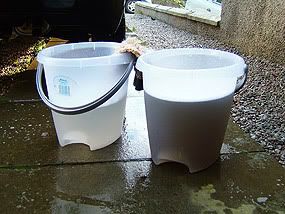
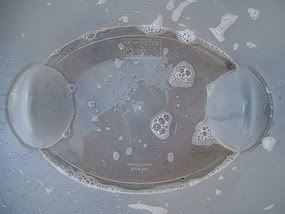
When using the mitt, try to follow the lines of the car and use only back and forth or side to side motions - circular motions will only make swirl marks more pronounced if you are unlucky enough to inflict any. It is better to wash your car in the shade if you can, so as to prevent the suds from drying out before rinsing off. If this is not possible, you should begin rinsing off sooner, panel by panel on really hot days. When rinsing off, we recommend using a hose with all of the end attachments removed - this encourages the rinse water to sheet off the panels, making drying easier.
With the bodywork and the windows now washed, the next thing you should do is swap to the microfibre wash mitt and tackle the wheels. If they are particularly dirty you can scrub them first with a soft tipped scrubbing brush. Be particularly generous with the suds, and take the time to get into all of the nooks and crannies and remove all of the brake dust (if you continually miss some wash after wash it will become more firmly bonded, making later removal more difficult). After washing all of the wheels, finish the process by washing the insides of the wheel arches, rinsing the mitt regularly. Finally, rinse everything off with the hose, including the bodywork again if it has dried off during the intervening period.
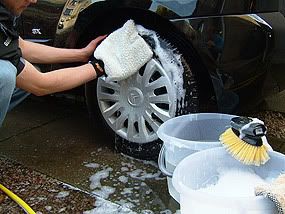
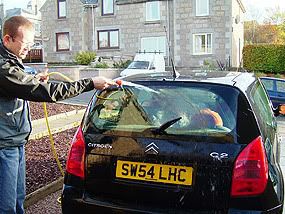
The penultimate step in the washing process is to dry all of the exterior surfaces. This is important, because leaving your car to dry off naturally can lead to the formation of unsightly water spots, which can actually damage painted surfaces if not removed. Although you are now working on clean surfaces, you still want to minimise the risk of inflicting swirl marks when drying off. For this reason, we recommend the use of a heavyweight waffle weave microfibre towel in place of a traditional chamois leather.
In contrast to traditional chamois leathers, heavyweight waffle weave microfibre towels are capable of absorbing many times their own weight in water, meaning that you can dry most cars without wringing out once. In addition, the ultra soft fibres and waffle weave design significantly reduce the chances of marking any exterior surfaces when drying off. A further benefit is that heavyweight waffle weave microfibre towels are considerably easier to clean and maintain than traditional chamois leathers.

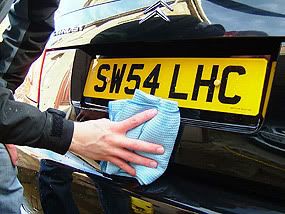
The final step in the washing process is to pack away all of the tools you have used, making sure everything is clean and ready for the next use. Firstly, you should thoroughly rinse out your buckets, and then store them upside down until they are next required. Secondly, you should rinse out any scrubbing brushes and then leave them to dry out naturally. Finally, you should rinse out your wash mitts and drying towel and then wash them all in a washing machine at a low temperature using a gentle non-biological liquid detergent (avoid soap powders and detergents containing bleach or fabric softeners), before allowing everything to dry out naturally.
The most important thing to remember about washing is that more often than not you are working on dirty surfaces. Your choice of products and technique is therefore very important, as you want to be able to gently lift away dirt and grime without damaging the underlying surfaces or stripping away existing wax or sealant protection. For this reason, we recommend the use of a lambswool wash mitt in place of a traditional sponge, and the use of a gentle shampoo in conjunction with the two bucket method.
If you examine traditional sponges and think about the washing process, it should become obvious to you that they are poorly suited to the task. This is because they provide no means of lifting particles of dirt safely away from the surfaces being washed. Instead, dirt particles are trapped against the face of the sponge and moved around over the underlying surfaces, creating fine scratches that are commonly referred to as swirl marks. The potential for inflicting such damage is greater during the winter months, when coarser particles of grit and road salt tend to accumulate on the exterior surfaces of your car in between washes.
In contrast to sponges, lambswool wash mitts feature a deep pile that enables particles of dirt to be drawn safely away from the surfaces being washed. Moreover, because the pile is fairly loose, particles of dirt can easily be rinsed out. These benefits can be reinforced by using the two bucket method, in which the first bucket is filled with suds and the second with rinse water. The idea behind this method is to load the mitt with suds, wash one panel of the car and then rinse the mitt thoroughly in the second bucket to release any trapped particles of dirt, before reloading the mitt with suds and moving on to the next panel.


The only downside of using lambswool wash mitts is that they are fairly delicate, and can easily be damaged by harsh use and snagging. For this reason, we recommend switching to a microfibre wash mitt when washing wheels and the insides of wheel arches. These areas tend to suffer from significant accumulations of gritty particles, and also tend to have a greater number of potential snags. However, because microfibre mitts have a shorter pile than lambswool mitts, extra care should be taken to rinse them regularly, in order to minimise the risk of marking delicate alloy rims. This risk can be further minimised by pre-washing wheels and the insides of wheel arches with a soft tipped scrubbing brush.
In order to generate a bucket of suds, you will need to add 1-2 oz of shampoo to an empty bucket and then fill it with lukewarm water. Your choice of shampoo is important, as it needs to be tough enough to dissolve dirt and grime, but at the same time not so aggressive as to strip or degrade existing wax or sealant protection. Many shampoos on sale in high street stores are actually quite aggressive, and thus best avoided - if you wash and protect your car regularly a gentle shampoo will suffice, as any dirt and grime will be loosely bonded and easy to remove. Many good quality shampoos also contain natural or synthetic oils, which encapsulate particles of dirt, further reducing the risk of inflicting swirl marks.
When it actually comes to the washing process, the first thing you should do is rinse as much dirt and grime off your car as possible using a hose or a pressure washer. If you opt for the latter use an RCD safety device and don't be too aggressive with the power setting - high pressure jets can strip paint from sharp edges (around wheel arches for example) and knock sticky balancing weights off alloy rims. It is worthwhile taking the time to thoroughly rinse the wheels and the insides of the wheel arches at this stage, as it makes later work with the microfibre wash mitt easier and less mucky.


After initial rinsing, the next thing you should do is wash all of the exterior surfaces bar the wheels and the insides of the wheel arches using a lambswool wash mitt in conjunction with a gentle shampoo and the two bucket method. Start with the roof, and then work down, washing the windows, the bonnet, the boot, the upper halves of the sides, the lower halves of the sides and finally the front and rear bumpers and the sills. Rinse the mitt thoroughly after every panel, and don't be stingy with the suds - make up another bucket if necessary. The same goes for the rinse bucket - the rinse water can get dirty very quickly, so keep an eye on it and replace it if necessary.


When using the mitt, try to follow the lines of the car and use only back and forth or side to side motions - circular motions will only make swirl marks more pronounced if you are unlucky enough to inflict any. It is better to wash your car in the shade if you can, so as to prevent the suds from drying out before rinsing off. If this is not possible, you should begin rinsing off sooner, panel by panel on really hot days. When rinsing off, we recommend using a hose with all of the end attachments removed - this encourages the rinse water to sheet off the panels, making drying easier.
With the bodywork and the windows now washed, the next thing you should do is swap to the microfibre wash mitt and tackle the wheels. If they are particularly dirty you can scrub them first with a soft tipped scrubbing brush. Be particularly generous with the suds, and take the time to get into all of the nooks and crannies and remove all of the brake dust (if you continually miss some wash after wash it will become more firmly bonded, making later removal more difficult). After washing all of the wheels, finish the process by washing the insides of the wheel arches, rinsing the mitt regularly. Finally, rinse everything off with the hose, including the bodywork again if it has dried off during the intervening period.


The penultimate step in the washing process is to dry all of the exterior surfaces. This is important, because leaving your car to dry off naturally can lead to the formation of unsightly water spots, which can actually damage painted surfaces if not removed. Although you are now working on clean surfaces, you still want to minimise the risk of inflicting swirl marks when drying off. For this reason, we recommend the use of a heavyweight waffle weave microfibre towel in place of a traditional chamois leather.
In contrast to traditional chamois leathers, heavyweight waffle weave microfibre towels are capable of absorbing many times their own weight in water, meaning that you can dry most cars without wringing out once. In addition, the ultra soft fibres and waffle weave design significantly reduce the chances of marking any exterior surfaces when drying off. A further benefit is that heavyweight waffle weave microfibre towels are considerably easier to clean and maintain than traditional chamois leathers.


The final step in the washing process is to pack away all of the tools you have used, making sure everything is clean and ready for the next use. Firstly, you should thoroughly rinse out your buckets, and then store them upside down until they are next required. Secondly, you should rinse out any scrubbing brushes and then leave them to dry out naturally. Finally, you should rinse out your wash mitts and drying towel and then wash them all in a washing machine at a low temperature using a gentle non-biological liquid detergent (avoid soap powders and detergents containing bleach or fabric softeners), before allowing everything to dry out naturally.
www.polishedbliss.co.uk
